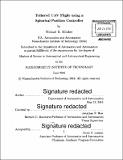| dc.contributor.advisor | Jonathan P. How. | en_US |
| dc.contributor.author | Klinker, Michael R | en_US |
| dc.contributor.other | Massachusetts Institute of Technology. Department of Aeronautics and Astronautics. | en_US |
| dc.date.accessioned | 2016-12-05T19:55:16Z | |
| dc.date.available | 2016-12-05T19:55:16Z | |
| dc.date.copyright | 2016 | en_US |
| dc.date.issued | 2016 | en_US |
| dc.identifier.uri | http://hdl.handle.net/1721.1/105620 | |
| dc.description | Thesis: S.M., Massachusetts Institute of Technology, Department of Aeronautics and Astronautics, 2016. | en_US |
| dc.description | Cataloged from PDF version of thesis. | en_US |
| dc.description | Includes bibliographical references (pages 143-144). | en_US |
| dc.description.abstract | In recent years, the aerospace community has seen a rise in the popularity of multirotor unmanned aircraft. This increase in popularity is in part due to the ability of a multirotor aircraft to hover, its simple dynamics, and its mechanical simplicity. Operating these unmanned aircraft indoors or outdoors is a well understood challenge, however these aircraft have predominantly been operated in an unconstrained area. This thesis investigates how to control a multirotor aircraft in a constrained environment, such as on the end of a tether. A position controller is presented for a multirotor UAV operating on the end of a fixed length, tensioned tether in spherical coordinates, which utilizes the vehicles relative position and tether dynamics to calculate control inputs and ensure flight stability. The proposed position controller was put through a series of verification and validation tests using both a simulated tether-aircraft system, as well as a quadrotor flown in the RAVEN indoor flight space in the MIT Aerospace Controls Laboratory. During simulated flight testing the spherical position controller showed a 35.7% decrease in tether tension, and during indoor flight testing the spherical position controller exhibited an 8.4% decrease in power consumption over the traditional Cartesian position controller while operating on the end of a fixed length tether. | en_US |
| dc.description.statementofresponsibility | by Michael R. Klinker. | en_US |
| dc.format.extent | 144 pages | en_US |
| dc.language.iso | eng | en_US |
| dc.publisher | Massachusetts Institute of Technology | en_US |
| dc.rights | M.I.T. theses are protected by copyright. They may be viewed from this source for any purpose, but reproduction or distribution in any format is prohibited without written permission. See provided URL for inquiries about permission. | en_US |
| dc.rights.uri | http://dspace.mit.edu/handle/1721.1/7582 | en_US |
| dc.subject | Aeronautics and Astronautics. | en_US |
| dc.title | Tethered UAV Flight using a spherical position controller | en_US |
| dc.title.alternative | Tethered unmanned aerial vehicle flight using a spherical position controller | en_US |
| dc.type | Thesis | en_US |
| dc.description.degree | S.M. | en_US |
| dc.contributor.department | Massachusetts Institute of Technology. Department of Aeronautics and Astronautics | |
| dc.identifier.oclc | 962735321 | en_US |
